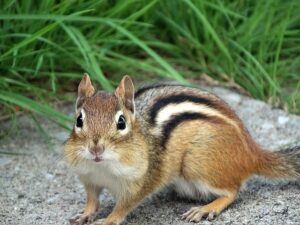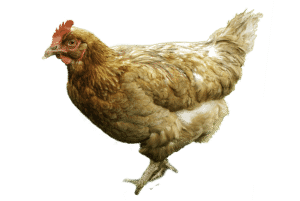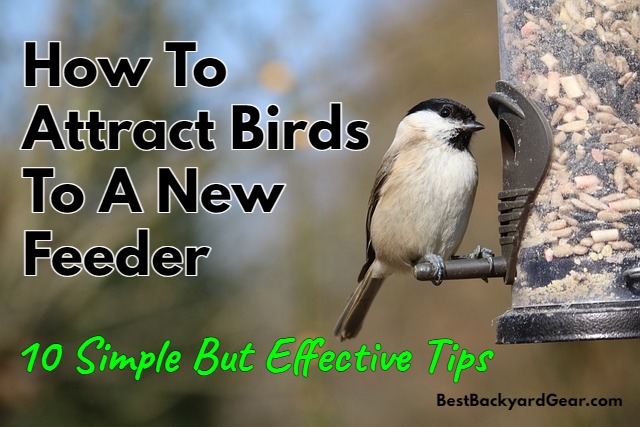
There’s something relaxing and heart warming about watching birds feed. If you just put out a new bird feeder, you’ll be hoping that birds flock to it quickly, of course, so that you can start enjoying the sight too. Is there anything you can do to “let them know” that the bird seed is there and waiting for them? How to attract birds to a new feeder is the question we’re looking at today.
Here are 10 simple yet effective tips that will help you attract birds to your new bird feeder. Give a few of them a try, and sit back to see how quickly they work (or don’t work… nothing is guaranteed!). And above all, relax and enjoy… bird feeders are not meant to be stressful additions to your yard. Have fun!

1. Spread some loose seed on the grass below the feeder.
This “advertises” the feeder from above, as birds flying overhead may notice the seed scattered on the grass before noticing it packaged nicely in the feeder. Birds find food visually.
2. Add a water source.
Birds are living creatures that need food AND water. If you’re in an area where temperatures work for it, consider adding a water source! Obviously a frozen bird bath won’t attract any feathered friends. But if you can, water will help draw birds quickly to your new feeder.
3. Make your water source audible!
Water poured into a simple bird bath is fine for birds, but it’s harder to find than water that is moving, bubbling, and dripping. If you can get a water feature of some sort where the water movement has a sound, even if it’s just slight, you’ll attract birds much more quickly to it!
4. Select your location wisely.
Pick a spot on your lawn near some evergreens, foliage or ground cover, if possible. Birds are skittish, and if they sense danger, they flee. They don’t love super exposed locations all that much, normally. Placing a bird feeder near a hiding place like an evergreen tree allows the birds to dart in and out, and can shelter many birds at a time.
(The evergreen tree beside our own bird feeder seems to be the hangout of a huge flock of starlings around breakfast time… we and our kids love watching them peek out of the leaves, check if the coast is clear, and dart out for some seed.)
Too close to other pet home is also not a great idea (chicken coops, rabbit hutches, etc.) Obviously, these are threatening to little birds.
5. Make sure you’re using fresh seed.
If there are 2 bird feeders in a general proximity, birds can tell the difference between old seed and new, and not surprisingly, will flock to the fresh source!
6. Choose good bird seed over cheap bird seed.
Birds are picky. If they don’t find seed they like in your blend, they will not return. Popular with most birds however, are the following: black oil sunflower seeds, white proso millet, and peanuts. Tip: stay away from cheap blends that have wheat or cracked corn listed as a primary ingredient, especially if you don’t want the grass below your stand covered with it – the birds will literally drop it over and over in search of the good stuff.
7. Add some more tempting treats.
Peanuts or all-natural peanut butter, orange slices, nectar or sugar water, black oil sunflower seeds, meal worms, even just bird seed blend with some more interesting varieties of seeds is better than the “super cheap, bulk bird seed bag” at your local store. Many of these “treats” do require special styles of bird feeders – learn more about them in this article here.
8. Get the right kind of bird feeder for the birds you want to attract.
There are a huge variety of bird feeders out there, and the various styles are designed to attract different types of birds. Platform feeders, tube feeders, log feeders… think about the birds you’ve seen in your area, and do some research on what type of feeder you should get to attract those birds to their new food source at your place. Here’s a great article about it.
 9. Time it right.
9. Time it right.
Some seasons are easier than others for starting up a bird feeder. Generally, the autumn months are the best for getting quick starts, as birds are searching for their winter homes. Spring and summer are full of natural food sources everywhere for them, so they’ll be less likely to stick around.
10. Simply put, just give it time.
They will eventually figure it out – and as soon as one bird finds it, they will spread the news. It may not be the answer you WANT, but unfortunately it may be true answer here… you can do all you want to speed up the process, but in the end, it may simply take a bit of time before the first bird sees it and squawks out the news.
Hopefully, friends, these 10 simple tips help you to get some feathered friends visiting your new feeder very soon!
Want a bit more info on the topic? Check out this video:

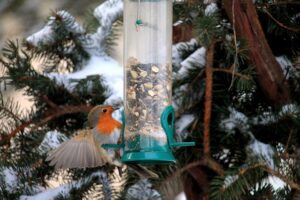
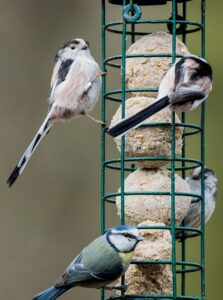
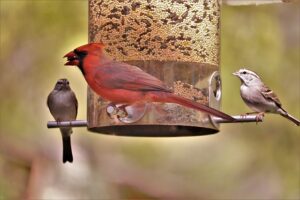 9. Time it right.
9. Time it right. 

